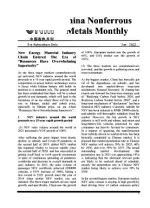China has Become a Big Power in Global Recycled Nonferrous Metal Industry
2011-08-15
According to Shang Fushan, Vice President of China Nonferrous Metals Industry Association,and Chairman of Recycled Metal Branch CNMIA, the output of key recycled nonferrous metals such as recycled copper, recycled aluminum, and recycled lead had increased by an annual average of 27% between 2000 and 2009, growing from 720,000 tons in 2000 to 6,330,000 tons in 2009. In 2009, the output of key recycled nonferrous metals accounts for 24.3% of the output of 10 nonferrous metals,equivalent to the total national output of ten nonferrous metals 10 years ago. The recycled nonferrous metal industry has developed into a certain scale.
In 2010, the output of ten nonferrous metals reached 31,350,000 tons, increased by 20.4%as compared with the same period of last year.Wherein, refined copper was 4,570,000 tons,up by 11.3%, primary aluminum was 16,190,000 tons, up by 26.1%, lead was 4,200,000 tons, up by 13.3%, and zinc was 5,160,000 tons, up by 18.5%.
Shang Fushan described the status quo of China’s recycled nonferrous metal industry by saying that recycled metal output accounts
for “one quarter of the world” in the total nonferrous metal output, and the recycled metal consumption accounts for “one third of the world” in the total nonferrous metal consumption.
Nevertheless, experts have pointed out that there are still problems concerning China’s recycled nonferrous metal industry, viz. low industry concentration degree, backward technology equipment and short supply of raw material support.
According to available statistics, there are over 300 recycled lead enterprises in China at present, but the average production capacity is only 4100 tons. There are only 2 recycled copper enterprises whose annual output can top 100,000 tons. Annual output of most enterprises stays below 30,000 tons. Large recycled aluminum enterprises have an annual production capacity of over 300,000 tons, but small enterprises can only produce several hundred tons annually. A low access standard of the industry has led to widely differing development levels, and there are still chaotic competitions in the market.
Li Shilong, Deputy Chairman of China Nonferrous Metals Industry Association Recycled Metal Branch, said, “The backward technology and equipment in China’s recycled nonferrous metal industry has put a great pressure on the environmental protection. Key indexes such as comprehensive energy consumption, emission of pollutants, and resource recycling utilization rate lag far behind those of developed countries. In the recycled copper industry many small and medium sized enterprises are still using outdated fixed anode furnace. In the recycled lead industry the production of small and medium sized enterprises accounts for 50% of the whole industry, the majority of which still use manual labor to dismantle waste lead-acid battery. The random dump of waste lead-acid liquid has brought great hazards to the environment.”
There is a shortage in the supply of scrap and old metal raw materials. China’s nonferrous metal consumption ranks a leading position worldwide. However, with a relatively low degree of industrialization and urbanization, the inadequate reserve of scrap and old nonferrous metal resource has led to a reliance on the import of scrap and old nonferrous metal raw materials. In 2009, China’s import of scrap and old nonferrous metal raw materials reached 6,650,000 tons (physical quantity). The development in global recycled resource industry has made the competition to secure scrap and old nonferrous metal resources increasingly fierce.The increasing shortage of scrap and old nonferrous metal raw materials has become a key factor in restraining the further development of China’s recycled nonferrous metal industry.
The restraint of nonferrous metal primary resource is aggravating China’s reliance on the import of key nonferrous metal mineral key resources. At present about 65% of copper raw materials, 55% of aluminum raw materials, and over 30% lead zinc raw materials depend on import, and those figures are still climbing.
Experts of the industry have estimated that during the “Twelfth Five Year Plan” period,with the increase in China’s demand for nonferrous metals, the recycled nonferrous metal industry will experience a golden time for rapid development. China’s central government has put forward a series of measures to drive forward a healthy development of the entire industry.
According to Zheng Yang, head of the Solid Waste Management Center, China’s Ministry of Environmental Protection, China has unveiled several dozen regulations and management rules closely related to recycled nonferrous metals. These management rules will raise the access threshold, and standardize management in the development of recycled nonferrous metal, in order to avoid the import of various “foreign rubbish”.
According to Shang Fushan, a top priority of the industry is to improve industry concentration degree. By 2015, China will develop a batch of large-scale enterprises each with an annual production above 100,000 tons in the recycled copper and recycled aluminum industries; the recycled lead industry will develop a batch of large-scale enterprises each with an annual output of above 50,000 tons. The industry concentration degree of top 10 enterprises will reach above 50%. The government will nurture and develop several key areas to concentrate the development of the industry, with a production capacity ratio of more than 80%.
Another priority is to improve the overall equipment and technology standard. By 2015,there will be a considerable improvement of the standard, with a widespread application of the mechanical dismantling pre-treatment technologies for scrap and old nonferrous metals,and an enhancement of the graded utilization standard.
